
|
You entered: ionization
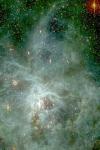 In the Heart of the Tarantula Nebula
In the Heart of the Tarantula Nebula
27.10.1999
In the heart of monstrous Tarantula Nebula lies one of the most unusual star clusters. Known as NGC 2070 or R136, it is home to a great number of hot young stars. The energetic light from these stars continually ionizes nebula gas, while their energetic particle wind blows bubbles and defines intricate filaments.
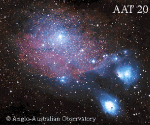 Nebulosity in Sagittarius
Nebulosity in Sagittarius
18.07.1996
What causes the colors in this beautiful nebulosity in Sagittarius? Dubbed NGC 6589 and NGC 6590, the colors of this nebulosity, are caused by gas and dust. The blue color of the nebula nearest the bright stars is caused by reflection off interstellar dust.
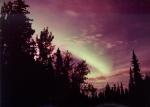 Aurora at Midnight
Aurora at Midnight
5.05.1998
What's happening behind those trees? Aurora. This picture was taken at midnight near Fairbanks, Alaska, and captures familiar trees, common clouds, and a glowing sky markedly different than a sunset. Particularly strange is the green auroral ring caused by ionized oxygen high in the Earth's atmosphere.
 NGC 2244: A Star Cluster in the Rosette Nebula
NGC 2244: A Star Cluster in the Rosette Nebula
16.03.2002
In the heart of the Rosette Nebula lies a bright open cluster of stars that lights up the nebula. The stars of NGC 2244 formed from the surrounding gas only four million years ago and emit light and wind that define the nebula's appearance today.
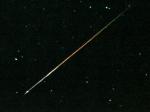 Rainbow Perseid
Rainbow Perseid
16.08.2002
While meteors do show colors, the colors aren't always seen with the unaided eye. Still, high speed color film recorded this rainbow-like trail as a meteor streaked through the early morning sky on August 13 above Sedona, Arizona, USA.
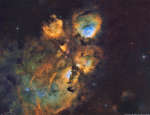 NGC 6334: The Cats Paw Nebula
NGC 6334: The Cats Paw Nebula
9.05.2022
Nebulas are perhaps as famous for being identified with familiar shapes as perhaps cats are for getting into trouble. Still, no known cat could have created the vast Cat's Paw Nebula visible toward the constellation of the Scorpion (Scorpius.
 NGC 2244: A Star Cluster in the Rosette Nebula
NGC 2244: A Star Cluster in the Rosette Nebula
22.08.2000
In the heart of the Rosette Nebula lies a bright open cluster of stars that lights up the nebula. The stars of NGC 2244 formed from the surrounding gas only four million years ago and emit light and wind that define the nebula's appearance today
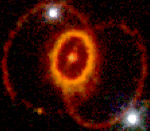 The Mysterious Rings of Supernova 1987a
The Mysterious Rings of Supernova 1987a
5.07.1996
What's causing those odd rings in supernova 1987a? In 1987, the brightest supernova in recent history occurred in the Large Magellanic Clouds. At the center of the picture is an object central to the remains of the violent stellar explosion.
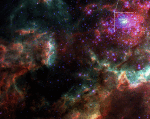 In the Center of 30 Doradus
In the Center of 30 Doradus
20.02.1999
In the center of 30 Doradus lies a huge cluster of the largest, hottest, most massive stars known. The center of this cluster, known as R136, is boxed in the upper right portion of the above picture.
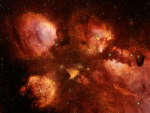 NGC 6334: The Cats Paw Nebula
NGC 6334: The Cats Paw Nebula
3.03.2008
Nebulae are perhaps as famous for being identified with familiar shapes as perhaps cats are for getting into trouble. Still, no known cat could have created the vast Cat's Paw Nebula visible in Scorpius.
|
January February March April May June July |
|||||||||||||||||||||||||||||||||||||||||||||||||